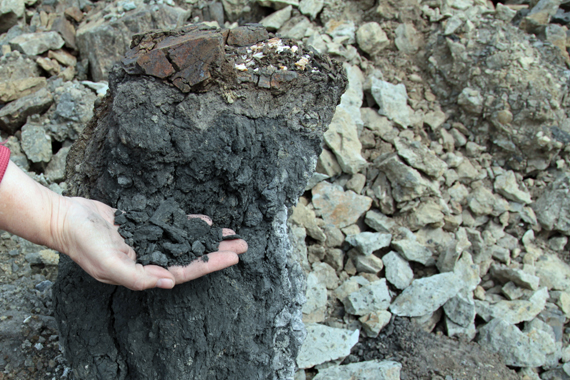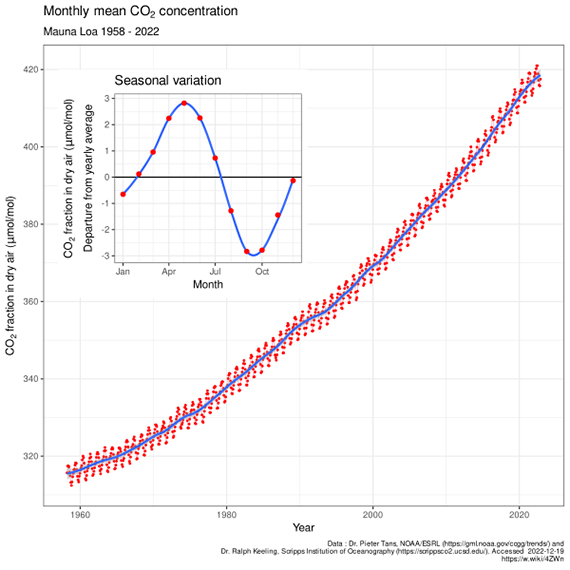 Arguments
Arguments
 Software
Software
 Resources
Comments
Resources
Comments
 The Consensus Project
The Consensus Project
 Translations
Translations
 About
Support
About
Support


Latest Posts
- Skeptical Science New Research for Week #14 2025
- Two-part webinar about the scientific consensus on human-caused global warming
- Sabin 33 #22 - How does waste from wind turbines compare to waste from fossil fuel use?
- Clean energy generates major economic benefits, especially in red states
- 2025 SkS Weekly Climate Change & Global Warming News Roundup #13
- Skeptical Science New Research for Week #13 2025
- Climate skeptics have new favorite graph; it shows the opposite of what they claim
- Sabin 33 #21 - How does production of wind turbine components compare with burning fossil fuels?
- China will need 10,000GW of wind and solar by 2060
- 2025 SkS Weekly Climate Change & Global Warming News Roundup #12
- Skeptical Science New Research for Week #12 2025
- Climate Fresk - a neat way to make the complexity of climate change less puzzling
- Sabin 33 #20 - Is offshore wind development harmful to whales and other marine life?
- Do Americans really want urban sprawl?
- 2025 SkS Weekly Climate Change & Global Warming News Roundup #11
- Fact brief - Is waste heat from industrial activity the reason the planet is warming?
- Skeptical Science New Research for Week #11 2025
- Visualizing daily global temperatures
- Sabin 33 #19 - Are wind turbines a major threat to wildlife?
- The National Hurricane Center set an all-time record for forecast accuracy in 2024
- 2025 SkS Weekly Climate Change & Global Warming News Roundup #10
- Fact brief - Is Greenland losing land ice?
- The Cranky Uncle game can now be played in 16 languages!
- Skeptical Science New Research for Week #10 2025
- Climate Adam: Protecting our Planet from President Trump
- Sabin 33 #18 - Can shadow flicker from wind turbines trigger seizures in people with epilepsy?
- Cuts to U.S. weather and climate research could put public safety at risk
- 2025 SkS Weekly Climate Change & Global Warming News Roundup #09
- Fact brief - Are high CO2 levels harmless because they also occurred in the past?
- Skeptical Science New Research for Week #9 2025
Archived Rebuttal
This is the archived Basic rebuttal to the climate myth "Breathing contributes to CO2 buildup". Click here to view the latest rebuttal.
What the science says...
|
By breathing out, we are simply returning to the air the same CO2 that was there to begin with. |
At a glance
We, and almost all of our relatives in the animal kingdom, are aerobic. That means we all depend on this simplified equation in order to function:
glucose + oxygen → carbon dioxide + water + energy
We breathe in oxygen and that oxidises carbohydrates in our body's cells. That chemical reaction gives us the energy required to perform all the varied tasks we do, from blinking to running a marathon. The products of the process are carbon dioxide and water. While the air we breathe in contains just under 420 ppm CO2, what we breathe out contains 40,000-50,000 ppm CO2, a hundredfold increase due to the simplified equation above.
Because we are breathing constantly, this rapid gas-exchange with our surroundings is also constant and, while each of us live, is perpetual. We are part of the fast carbon cycle that involves the movements of carbon through the living world. Of course, the living world also includes plants. Plants take in carbon dioxide to react in the presence of sunlight with the water in their cells. That, in a nutshell, is photosynthesis, the process responsible for the plant-based carbohydrates we eat.
We are vastly outnumbered in terms of carbon biomass by the plant kingdom. Of the estimated nearly 500 billion tonnes of biomass carbon on Earth, the animals account for just 0.4% whilst the plants represent 90%. No wonder that the graphs of measured CO2 levels show an annual fluctuation, forming a symmetrical wobble. The wobble represents the Northern Hemisphere seasons because that's where most of Earth's land masses are found. In the growing season when the plants are busy photosynthesising, CO2 falls, only to rise again in the dormant season. The annual wobble is like the heartbeat of the planet, a regular rhythm along the rising slope that represents our emissions from fossil fuel burning.
Let's imagine a world without fossil fuel-burning. The annual wobble from the seasonal growth and dormancy of plants would be superimposed upon a near-flatline of CO2 levels over human lifetimes. Only occasional events, occurring over tens of thousands to many millions of years, would perturb that near-flatline. That's because there is a second, slow carbon cycle that operates over geological time-scales. In the geologic past, sudden changes in CO2 levels have occurred, primarily due to volcanism on a scale no human, living or dead, has ever witnessed. The fossil record tells us the outcome has never been good.
Fossil fuels are part of the slow carbon cycle. They represent one of several long-term geological reservoirs in which carbon gets locked away. But because we are digging or pumping fossil fuels from the ground and burning them, it is the slow carbon cycle that we are interfering with. No other species has ever intentionally interfered with the slow carbon cycle: this is a first on Planet Earth in its 4.5 billion year long existence. The person quoted in the myth box above is a geologist. He should know better.
Please use this form to provide feedback about this new "At a glance" section. Read a more technical version below or dig deeper via the tabs above!
Further details
The very first time you learned about carbon dioxide was probably at school, where you were taught that we breathe in oxygen and breathe out carbon dioxide. The process, known as aerobic respiration, is something the vast majority of animals do. In our cells, the following enzyme-controlled reaction is taking place:
C6H12O6+6O2 → 6CO2+6H2O
It's a bit more complicated than that, but the equation is a representative overview. Carbohydrate is oxidised to carbon dioxide and water. The reaction is exogenic - meaning it releases energy at around 3000 Kilojoules per mole of glucose. And while we breathe in air with almost 420 ppm CO2 (2023 figure), it should come as no surprise that the air we breathe out contains 40,000-50,000 ppm (4-5%) CO2, representing a hundredfold increase. That's the product of aerobic respiration.
When confronted with the challenge of reducing our carbon emissions from the burning of fossil fuels, some people angrily proclaim, "why should we bother? Even breathing out creates carbon emissions!"
If someone makes such a statement, they are missing two crucial points. Firstly, our respiration doesn't matter in the big scheme of things. In terms of carbon biomass, we are dwarfed by the plant kingdom. Animals only account for a paltry 0.4% of the estimated near-500 billion tonnes of biomass carbon on Earth. Plants make up 90%.
Through photosynthesis, plants take in carbon dioxide and release oxygen, in a chemical reaction that is essentially the opposite to our aerobic respiration. Plants do perform some respiration, because they need to metabolise as well, but it is outweighed by the photosynthesis. The carbon they collect from the CO2 in the air, converted by photosynthesis into carbohydrates, forms their tissues - roots, stems, leaves, fruit and so on. Such tissues are eaten by all sorts of animals, which in turn are eaten by other animals. We humans are part of this food chain. All the carbon in our body comes either directly or indirectly from plants, which took it out of the air only recently. When we breathe out, all the carbon dioxide we exhale is simply being returned to the air. We are simply giving back the same carbon that was there to begin with. In doing so, we are actively participating in the fast carbon cycle. But our participation is tiny compared to that of plants.
The Keeling Curve (fig. 1) is the graph showing rising CO2 levels as measured at Mauna Loa and other observatories. On it, the plant world's participation in the fast carbon cycle can be seen. Due to photosynthesis, CO2 levels show an annual fluctuation, forming a regular wobble. The downward part of the wobble represents the Northern Hemisphere growing season. Since that's where most of Earth's land is distributed, it's where most of the CO2 drawdown takes place. In the Northern Hemisphere winter, when most plants are dormant, you get the upwards part of the wobble. The wobble, like a planetary heartbeat, is a regular rhythm superimposed upon the rising slope that represents our emissions from fossil fuel burning.
Fig. 1: The Keeling Curve - monthly mean CO2 concentration data (with the occasional volcanic anomaly filtered out), Mauna Loa Observatory, 1958-2022. Inset shows the annual 'wiggle' caused by seasonal plant-growth and dieback in the Northern Hemisphere. Image licensed under the Creative Commons Attribution-Share Alike 4.0 International licence.
Secondly, fossil fuels are the remnants of the fast carbon cycle, fortuitously preserved at various points along the geological time-line. That burial and preservation locked them out of the fast carbon cycle, putting them into the long-term storage part of the slow carbon cycle. Normally the slow carbon cycle operates over geological timescales. Thus, some of the coal we've mined has been more than 300 million years in storage, belonging, appropriately enough, to the Carboniferous period.
Forget about breath. Our carbon emissions from the slow carbon cycle are a) colossal and b) geologically unique. No other species in Earth history has deliberately disturbed the slow carbon cycle. But it has been disturbed - occasionally - by geological processes. Magma has occasionally cooked coal-deposits, as has been observed in Siberia (fig. 2). That rapid release episode, at the end of the Permian period 250 million years ago, didn't work out well. Biodiversity took a massive hit. It recovered – but the recovery took around ten million years.

Fig. 2: masses of coal caught up in basalt, Siberian Traps Large Igneous Province, from Elkins-Tanton et al. 2020. The rising magma interacted with and thoroughly cooked a major coal-basin, releasing a colossal amount of fossil carbon over a few thousand years. The result was catastrophic with the largest mass-extinction of the entire fossil record. Photo: Scott Simper, courtesy of Lindy Elkins-Tanton.
Weathering, plate tectonics, deformation and metamorphism of rocks have all affected CO2 levels - over millions of years. And that's the point. We are doing to our atmosphere, in a few centuries, what most geological processes could only accomplish over millions of years. Through fossil fuel burning, we are performing a unique, vast and uncontrolled experiment with our home planet – the only one we have.
This new animation was published by Dr. Patrick T. Brown (Carnegie Institution for Science, Stanford University) in September 2018, to explain how human respiration fits in to the overall process.
[youtube id="Ah09gPZDymg"]
Updated on 2018-09-13 by BaerbelW.
THE ESCALATOR

(free to republish)

























































